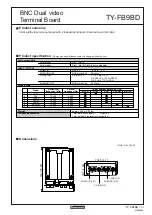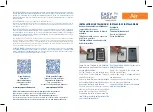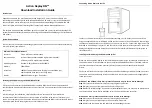
MSI-3750 Digital Weight Indicator
◆
User Guide
Page 75
M E A S U R E M E N T S Y S T E M S I N T E R N A T I O N A L
COMM PORT 2 (2nd Comm Port Option only)
Comm Port 2 can be configured in three ways:
1)
RS-232 – In the RS-232 mode, the electrical characteristics of the serial
output is configured to conform to the EIA Standard EIA-232-D (downward
compatible with RS-232-C). The port is configured as DCE. Cable connec-
tions include RXD (input), TXD (output), Signal Ground, and RTS (Out-
put). The RTS output is passive and indicates to the DTE port that the cable
connection is made. There is no shield ground connection due to the isolated
port. Tie the shield ground to the chassis of the DTE side. Cut any shield
ground off and insulate it from the MSI-3750 chassis.
2)
RS-485 – The RS-485 mode is a half-duplex serial communications channel
capable of driving up to 4000 feet of cable. In addition, 32 RS-485 devices
can be daisy-chained together providing networking capabilities. In accor-
dance with RS-485 standards the cabling should be terminated at the
extreme ends of the cable (not at each node) with a 120
Ω
resistor in series
with a 0.1
µ
F ceramic capacitor. Cable Connections are I/O+, I/O-, and
signal ground. Serial data is both transmitted and received on the same lines
(half duplex). As an output, the 485 Driver is compatible with RS-422
Receivers.
3)
Fiber-Optic Output (Option) – The Fiber-Optic Output provides an output
capable of driving 3000 feet of plastic fiber optic cable. This is an output
only and intended for driving printers or transmitting data to a computer
when no computer control or handshaking is necessary.
COMM PORT CABLING
The Comm Port 1 RS-232 connections are made into TB3 found on the circuit
board internal to the MSI 3750. Due to wash down requirements, no interface
cable is supplied. Cables with an outside diameter of .187” to .300” (5mm to
7.5mm) are sealable with the watertight fitting. Preferably, cables should have
twisted pair connections with an over shield. In the table below, twisted pairs are
represented by A, B, and C.
RS-232 Cable Installation, Comm Port 1
1)
Unplug the power cable. Remove the 10 screws holding the front panel on.
2)
Strip the outer insulation 1.5” (40mm) from the cable. Peel back the foil
shield (if any) being careful not to nick the conductors. Cut off the foil
shield leaving the drain wire intact. Strip 3/16” (5mm) from each conductor
and tin the wires. Slip a 1 5/16” (33mm) piece of sleeving over the drain
wire and tin the end of the drain wire. It is also wise to shrink a short piece
of heat shrink tubing over the end of the outer jacket to further insulate the
shield.
3)
Loosen the center watertight feedthrough and remove the white plug. Feed
the RS-232 cable through the center watertight feedthrough.
4)
The terminal block uses push levers. Insert the wires as shown in the
Summary of Contents for MSI-3750
Page 145: ......
















































